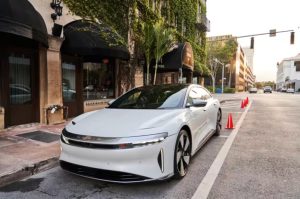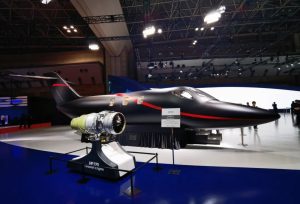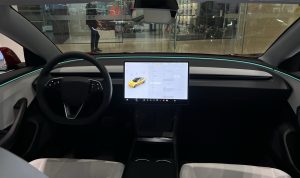The AEB Dispute Between Xiaopeng He and Richard Yu: Resolving the Anxiety Behind
8 min read
The automotive industry is never short of topics, and this time, it revolves around the “AEB technology.” The remote duel involves Xiaopeng He and Richard Yu, the former being the founder of Xiaopeng Motors, and the latter serving as the Executive Director, CEO of the Consumer Business Group, and Chairman of the Intelligent Automotive Solutions Business Unit at Huawei – renowned for his outspoken nature and often referred to as “Big Mouth Yu.”
This is a storm sparked by the “AEB dispute,” not only leading to a verbal clash between the two individuals but also attracting attention from various leaders in the automotive industry. The dispute escalated to involve the respective companies, reaching its peak when a third-party organization conducted a test on AEB’s recognition of static fake cars, pushing the controversy even further.
Finally, Xiaopeng He concluded the episode with a post saying, “Thanks to Elder Yu,” indicating a temporary end to the dispute.
The Beginning and End of the Storm
On November 9th, Xiaopeng He posted on Weibo, saying, “Thanks to Elder Yu for his advice and generosity. Sometimes, misunderstandings can turn into good friendships.” This was seen as a signal of a reconciliation between the two.
On the same evening, when Richard Yu took the stage at a Huawei press conference, he responded once again, stating that AEB is just a small case and, “if we unleash more features, we will be even stronger.”
What started as a dispute unfolded from an interview with Xiaopeng He on November 1st, where he mentioned, “When competitors talk about AEB, I think 99% of it is fake. It’s just deception…”
The identity of the “competitor” referred to as “99% fake” became a topic of speculation. In October, Xiaopeng Motors turned the tables with the new M7, showcasing AEB as one of its highlights. Richard Yu was excited and even posted on social media, claiming they had created a miracle and made a comeback.
Within two days, on the evening of November 3rd, Richard Yu took to Weibo, sharing an article titled “OTA Major Upgrade, Smart Driving Can Now be Used Across the Country,” and commented, “What is AEB? Some heads of car companies don’t even understand it.” In the comments, he continued to criticize, saying, “Some people don’t even understand what AEB is! Talking about smart driving is just nonsense, almost the same!”
The next day, various outspoken leaders from emerging carmakers joined in the discussion, creating a heated debate known as the “AEB dispute.” Tengshi’s General Manager Zhao Changjiang, Avita’s CEO Tan Benhong, and NIO’s CEO Zhang Yong, among others, expressed their opinions. Li Xiang, known as the “Weibo King of the Car Industry,” also made a statement: “I won’t argue with Huawei; I can’t win.”
On the same night, Xiaopeng He responded on Weibo, stating, “Can’t win against us? Let’s just look at the results then,” and mentioned that Xiaopeng’s self-developed AEB scored close to full marks in official tests, with the P7 model receiving dual five-star certifications from Euro NCAP and C-NCAP.
The dispute escalated further when a third-party organization, Dcar, conducted tests on AEB’s recognition of static fake cars. The results were not favorable for Xiaopeng Motors, with the G6 model failing twice at 40 km/h. This triggered a response from Xiaopeng He on November 8th, criticizing the testing methods and claiming that some well-performing models were taking advantage of the system.
However, within a day, Xiaopeng He changed his tone and initiated a “conciliation” mode, thanking Richard Yu for his advice and generosity. He posted on Weibo, “This morning, I had a discussion with Elder Yu about technological routes. I believe this kind of technological debate will ultimately benefit users,” expressing gratitude for Yu’s suggestions.
This marked the end of the controversy.
Why the “AEB Dispute”
AEB, or Autonomous Emergency Braking, is not a new technology, with its application tracing back over 60 years. The technology has been extensively used in traditional internal combustion engine vehicles. The companies led by Xiaopeng He and Richard Yu faced a life-threatening crisis at the end of last year and achieved a remarkable turnaround in October this year.
So why did the two engage in a dispute over the seemingly trivial “AEB technology”?
In July, a widely circulated report on AEB testing by a vertical media outlet highlighted the superior performance of Huawei’s AEB in the context of other car manufacturers. Two months later, during the launch of the new M7, Richard Yu claimed that the AEB’s highest braking speed had increased to 90 km/h, reducing accidents caused by distracted driving and complex road conditions by 90%.
On October 6th, Richard Yu posted on Weibo, saying, “Since the launch of the new M7 on September 12, the first sales have exceeded 50,000 units.” The excitement was evident.
The mention of a braking speed of 90 km/h by Richard Yu was not acknowledged by Xiaopeng He. He stated that AEB discussions in the current (automotive) industry are mainly focused on longitudinal AEB, and in most cases, the triggering speed is within 60 km/h. If the speed is too high, an accidental brake could cause significant shock to users. In China, AEB-related standards and methods are still underdeveloped.
At present, AEB testing in the industry is mainly based on C-NCAP standards. C-NCAP has clear and strict requirements for the speed of AEB testing: in the three AEB tests for automatic emergency braking in rear-end collisions, automatic emergency braking for pedestrians, and automatic emergency braking for two-wheelers, the maximum speed of the test vehicle is within 60 km/h.
Although AEB has been applied to traditional combustion engine vehicles for many years, as we enter the era of electric vehicles, users have higher expectations. Users expect vehicles not only to identify other vehicles in front but also pedestrians, small objects, irregular obstacles, animals, and more. Therefore, the current quality of AEB technology to a large extent reflects the excellence of intelligent driving.
Xiaopeng He and Richard Yu’s dispute was probably a predestined confrontation. In the second half of 2021, Xiaopeng Motors decided to independently develop a non-dependent high-precision map-assisted driving algorithm. At that time, Wu Xinzhou, who was still with Xiaopeng Motors, led a team to develop XNGP, the second-generation intelligent assisted driving system launched after XPILOT. In a later interview with “LatePost,” Wu Xinzhou expressed his lack of agreement when Richard Yu mentioned that Huawei’s automatic assisted driving was the best on the ground in China, stating that he believed they should be in the first position.
Xiaopeng He and Richard Yu have been competing in the field of smart driving since Xiaopeng Motors’ inception. This time, the dispute over “AEB technology” seemed incidental but was, in fact, inevitable.
Anxiety During the Shuffling Period
2023 is a critical year for many emerging automakers, a “life or death year.” Some car companies
are sliding into the abyss, such as Aiways, Wey, Evergrande, and Horizon, all facing a life-threatening situation.
Xiaopeng Motors and Huawei’s HiCar (now branded as Huawei ADS) experienced a turnaround in October. Xiaopeng Motors, with the popular G6 model, achieved monthly sales exceeding 20,000 units in October, a staggering 292% year-on-year increase. Similarly, Huawei’s HiCar, with the launch of the new M7, secured over 50,000 orders in less than a month.
Now, both companies appear to be on an upward trajectory. However, just a few months ago, they were struggling on the brink of collapse. Richard Yu’s statement on October 6th, “Coming back to life, it’s really not easy!” resonates with the challenges they faced.
The previous-generation G9, released at the end of 2021, became Xiaopeng Motors’ “Waterloo,” dragging the company into a dark period. In 2022, hindered by factors like the G9, Xiaopeng Motors became the underperformer among the “three musketeers” including NIO and Li Auto. Not only did the net loss increase from less than 5 billion yuan the previous year to 9.1 billion yuan, but its gross profit margin fluctuated around 10%, making it the company with the poorest gross profit margin among the “three musketeers.” The sales volume also significantly deviated from the target.
Simultaneously, the company’s organizational structure underwent a major adjustment. In September, during the “Fighting Again with G9” launch event, Xiaopeng He revealed that out of 12 high-level executives mentioned in the company’s previous year’s financial report, only two remained.
He mentioned, “In the past year, we have undergone a thorough transformation in terms of organization, products, technology, and marketing. Through the dual transformation of product technology architecture and organizational management capabilities, we aim to reclaim lost ground with the 2024 Xiaopeng G9.”
Now, with the success of the G6, Xiaopeng Motors has seemingly turned the tide. However, it doesn’t mean long-term relief, as the industry competition is becoming more intense. Xiaopeng Motors set a sales target of 200,000 units for this year but only achieved 101,000 units in the first ten months. Achieving the remaining 50% of the goal in just two months is challenging.
When Huawei entered the automotive field, it initially proclaimed, “Huawei does not make cars; it only uses ICT technology to help car companies build good cars.” Huawei’s automotive business has three main modes: parts mode, Hi mode, and Smart Select (智选) mode. After a few years of exploration, Smart Select mode gradually became its main focus, and the new M7 from Huawei’s car brand, HiCar, was the first model under this mode.
As Richard Yu expressed, HiCar faced a life-or-death crisis before. After the launch of the M7, sales were initially slow. By early this year, monthly sales were just over 1,200 units, dropping to just over 400 units by June. Meanwhile, the sluggish sales of the M7 impacted the entire HiCar brand, with monthly sales shrinking to below ten thousand units.
The explosive success of the new M7 is crucial for Huawei’s automotive business. Therefore, it’s understandable that when Xiaopeng He mentioned that the AEB of a competitor is “99% fake,” even without naming the competitor, Richard Yu had to step in and engage in the dispute.
The AEB technology dispute, which unfolded as a storm, not only educated the public but also garnered attention and increased visibility for both companies.
Of course, for the industry, such remote disputes are not a bad thing. Only when companies are challenged can they be motivated to innovate and break through, ultimately raising the overall level of new energy vehicles domestically and internationally.
Now, as the “Matthew Effect” in the industry continues to highlight, with new energy vehicles entering a phase of a brutal price war to compensate for quantity, the survival pressure on emerging carmakers has not decreased but increased.
In this landscape of companies falling one after another, Xiaopeng Motors and HiCar, along with other new and old forces in the new energy vehicle industry, are inevitably experiencing anxiety during the shuffling period. The companies that can laugh in the end will undoubtedly be those with the highest technological content, providing users with the ultimate experience.



